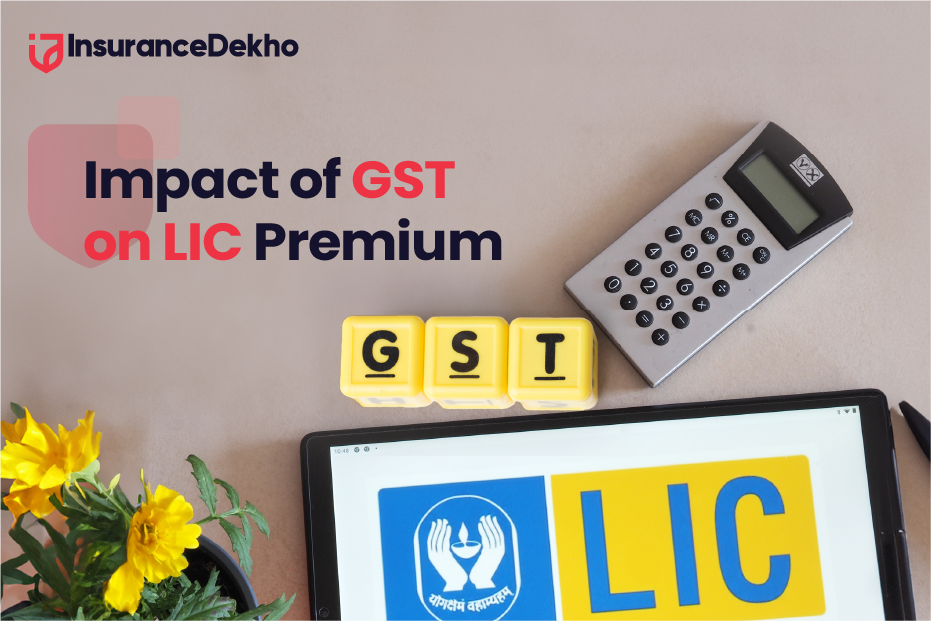Learn the Impact of GST on LIC Premium
Goods and Services Tax or GST is a topic that has been buzzing around for years, affecting many aspects of our country. One such aspect is the insurance industry, particularly life insurance.
When GST came into play in 2017, it brought changes to the premiums policyholders pay for life insurance including for Life Insurance Corporation policies. Even though the price of premiums went up, still GST has some positive impacts on the life insurance sector.
So, in this article, let us understand the impact of GST on LIC premiums.
Table of Contents
- What is GST?
- Impact of GST on LIC Premiums
- Current GST Rate Applicable to LIC Premiums
- GST Applicable to Various Other Components
- Exemptions from GST in LIC Premiums
- Taxation Scenarios for LIC Plans Under GST
- How to Save Taxes Under Life Insurance?
- Common Myths About GST on Life Insurance Premium
- Conclusion
- Frequently Asked Questions (FAQs)
What is GST?

GST, or Goods and Services Tax, is an indirect tax introduced on July 1, 2017. The main purpose of introducing GST was simplifying how taxes work in India. Before the introduction of GST, there were ample number of taxes, which created a confusion for people. But later on, GST brought all those taxes under one roof, making things much simpler.
Now, when you paid for your life insurance before GST, there were different taxes like Basic Service Tax, Swachh Bharat Cess, and Krishi Kalyan Cess, adding up to 15%. After GST, it became a flat 18%, meaning you had to pay a bit more for your life insurance.
Even though GST made life insurance premiums a little expensive, it also encouraged insurance companies to compete. As a result, the life insurance providers started lowering their prices. And the best part? It made insurance prices less confusing, allowing you to choose the right life insurance plan for you and your family.
Impact of GST on LIC Premiums
There are three primary categories of LIC policies: Term Insurance Plans, Endowment Policies, and Unit Linked Insurance Plans (ULIPs). All of them offer various perks and coverage options.
Before the implementation of the Goods and Services Tax (GST), life insurance premiums were subject to a 15% service tax. However, these rates changed when the GST was implemented. Now, the GST on LIC premium is 18%, which is higher than the previous service tax rate of 15%.
So, what does this mean for policyholders?
It eventually increased the charges for life insurance premiums. In simple terms, the amount you pay for your LIC coverage has now gone up from 15% to 18% due to the change in the GST rate for LIC premiums.
Current GST Rate Applicable to LIC Premiums
The table below highlights the current GST on LIC premiums:
|
LIC Policy Type |
Value of Supply |
Pre-GST Service Tax |
GST Rate |
|
LIC Term Insurance and Riders |
Premium |
15% |
18% |
|
LIC Life Insurance/Endowment Plans (NBP incl. single premium) |
Premium |
3.75% - 1st year 1.88% - 2nd year onwards |
4.5% - 1st year 2.25% - 2nd year onwards |
|
LIC Pension Plans (NBP incl. single premium) |
Premium |
3.75% - 1st year 1.88% - 2nd year onwards |
4.5% - 1st year 2.25% - 2nd year onwards |
|
LIC Annuity Plans with a single premium |
Premium |
1.50% |
1.80% |
|
ULIPs |
Charges |
15% |
18% |
GST Applicable to Various Other Components
Apart from the regular premiums you pay for your insurance policy, several other components listed below attract GST charges.
- Cheque Dishonor Charges: In cases where a cheque used for premium payment gets dishonored, leading to additional charges, an 18% GST rate is applied. This includes not only the cheque dishonor fees but also any associated postage charges.
- Delayed Premium Payments: If you happen to pay your insurance premium after the due date, a GST rate of 18% is applied to the interest charged on the delayed payment. So, it's essential to make timely payments to avoid extra charges.
- Other Policy-Related Fees: Last but not least, various fees associated with policy management are subject to GST. This includes charges for quotations, duplicate policy preparation, alterations, as well as fees for policy termination or changes in nominations.
Exemptions from GST in LIC Premiums
By Notification No. 12/2017, issued on the 28th of June 2017, certain insurance services and schemes are granted exemption under the GST regime. These exemptions include:
- Insurance services provided by the Insurance Regulatory and Development Authority (IRDAI)
- Annuity plans fall under the National Pension Scheme (NPS) and are regulated by the Pension Fund Regulatory and Development Authority (PFRDA)
- Life insurance services offered through government-run schemes, such as:
- Janashree Bima Yojana (JBY)
- Varishtha Pension Bima Yojana (withdrawn in 2015-16)
- Pradhan Mantri Jeevan Jyoti Bima Yojana
- Pradhan Mantri Jan Dhan Yojana
- Aam Aadmi Bima Yojana (AABY)
- Pradhan Mantri Vaya Vandana Yojana
- Life micro-insurance products with a maximum coverage of Rs. 2 lakhs, approved by the IRDAI
- Any other insurance scheme implemented by State Governments, as notified by the Indian Government upon the recommendation of the GST Council.
Taxation Scenarios for LIC Plans Under GST
It's important to understand that the majority of insurance plans consist of two primary components: Investment and Risk Protection. Only the portion of the insurance premium that pays for Risk Protection is subject to GST.
Let's now evaluate how GST is applied to different LIC plans:
-
GST Imposed on LIC Term Plans Premium
Term plans are designed to offer financial protection to the policyholder's beneficiaries in the event of their death during the policy term. The GST applies to the premiums paid for these term insurance plans, which is 18%.
This means that if your annual premium is, for instance, Rs. 15,000, you would need to pay an additional Rs. 2700 as GST (18% of 15,000).
It's important to note that this GST rate also extends to any additional premiums paid for add-ons or riders.
-
GST on LIC Endowment Plans Premium
Endowment plans from LIC provide a combination of life insurance coverage and investment benefits. The application of GST on endowment plans is quite tricky to understand. In the initial year of the policy, a GST rate of 4.5% is applied to the premiums. For subsequent years, the GST rate decreases to 2.25%.
For instance, if the first-year premium of your LIC policy is Rs. 15,000, the GST payable would be Rs. 675, and for subsequent years, it would be Rs. 337.5.
-
GST on LIC Annuities or Pension Plans Premium
Annuity plans involve a lump sum payment made by the policyholder, and GST is applied to this lump sum amount. The GST rate for annuities or pension plans is set at 1.8%.
For example, if you invest Rs. 15,00,000 in an annuity plan, the applicable GST would amount to Rs. 27,000.
-
GST on LIC ULIPs Premium
Unit Linked Insurance Plans (ULIPs) combine elements of both insurance and investment. Unlike some other insurance plans, GST is not directly levied on the premiums paid for LIC ULIPs. Instead, a GST rate of 18% is imposed on the fund management charges associated with these plans. These charges include various fees like premium allocation charges, policy administration charges, and mortality charges. Notably, the invested portion of the premium is exempt from GST.
-
GST Imposed on Other Aspects of LIC Plans
Beyond premiums, there are various other components associated with LIC plans that attract GST. Late payment fees or premiums, for instance, are subject to an 18% GST rate. Similarly, charges related to Cheque Dishonour (CDA), and other fees like duplicate policy preparation charges, alteration charges, and quotation fees are also subject to GST at different rates.
How to Save Taxes Under Life Insurance?
When GST was introduced, life insurance premiums increased by 3%. However, in India, there are ways to save on income tax, even with higher premiums. These savings apply not only to your life insurance premiums but also to the GST you pay on them.
The following Sections of the Income Tax Act, 1961, offer common ways to save on income tax, especially for life insurance premiums.
1. Section 80C Deductions
You can avail tax deductions of up to Rs. 1.5 lakhs under Section 80C, covering expenses like life insurance premiums and investments in instruments such as ELSS and PPF.
2. Section 10(10D) for Maturity Proceeds
Under Section 10(10D), the maturity proceeds from life insurance policies are exempt from tax. This applies to policies with a premium not exceeding 10% of the sum assured.
3. Consider Medical Riders for Added Deductions
Premiums paid for medical riders can be eligible for deductions under Section 80D.
Common Myths About GST on Life Insurance Premium
The most common myths relating to GST on life insurance prmeium includes:
Myth 1: GST is Charged on the Entire Premium Amount
Reality: GST is not levied on the entire premium amount. Instead, it applies only on the portion of the premium that goes towards the policy's risk coverage. The investment component of the premium is exempt from GST.
Myth 2: GST Rates are the Same for All Life Insurance Policies
Reality: GST rates can vary based on the type of life insurance policy you buy. For example, term insurance plans attract different GST rates in comparison to other policies like Endowment or Unit-linked Insurance Plans (ULIPs).
Conclusion
With the GST rate for LIC premiums increasing from 15% to 18%, policyholders now face slightly higher charges for their life insurance coverage. This change has implications for various LIC policies, including Term Insurance Plans, Endowment Policies, and Unit Linked Insurance Plans (ULIPs), each with its unique GST rate structure.
While the rise in GST may contribute to increased costs for policyholders, it has also encouraged healthy competition among insurance providers. As insurance companies strive to remain competitive, they have been prompted to lower prices, making life insurance more accessible in some ways.
And, when it comes to buying life insurance policies, don’t forget that InsuranceDekho is always there for you. So, contact us now on 755 1196 989 and purchase the life insurance polciy of your choice.
Frequently Asked Questions (FAQs)
Q 1. What is GST, and when was it introduced?
Ans. GST, or Goods and Services Tax, was introduced in 2017 to simplify India's tax system. It replaced various confusing taxes with a single and more standardised tax structure.
Q 2. How did GST impact life insurance premiums?
Ans. Before GST, life insurance premiums were subject to a 15% service tax. After GST, the rate increased to 18%, making life insurance a bit more expensive for policyholders.
Q 3. What is the GST rate for LIC Endowment Plans Premiums?
Ans. For LIC Endowment Plans, a GST rate of 4.5% is applied in the first year, and subsequently, it decreases to 2.25% for the following years.
Q 4. How does GST apply to LIC Annuities or Pension Plans?
Ans. Annuities or Pension Plans involve a lump sum payment, and GST is applied at a rate of 1.8% on this lump sum amount.
Q 5. Is GST directly applied to LIC ULIPs premiums?
Ans. No, GST is not directly applied to the premiums of LIC ULIPs. Instead, a flat rate of 18% is imposed on the fund management charges associated with these plans.




























